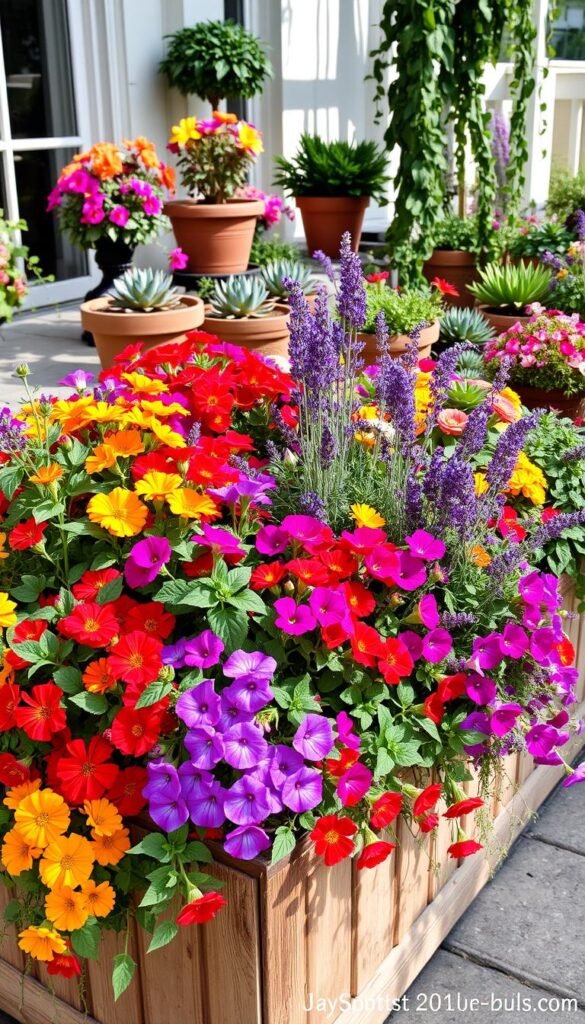Imagine stepping outside to a vibrant display of blossoms that instantly lifts your mood. With the right approach, even a tiny balcony or patio can become a lively oasis. This guide will show you how to create eye-catching arrangements using pots and planters, blending practicality with artistic flair.
Experts like Katrin Ray Shumakov emphasize matching your greenery to its home. “The perfect pairing of flora and vessel creates harmony,” she notes. Mark Thompson adds that thoughtful planning helps your living artwork thrive through seasons. You’ll discover how texture, height, and color work together to make ordinary spaces extraordinary.
Before diving in, consider sunlight patterns and maintenance needs. Some species flourish in cozy quarters, while others demand room to stretch. We’ll explore popular picks that deliver maximum impact with minimal fuss – from cascading vines to bold focal points.
Key Takeaways
- Transform small areas using strategic plant combinations
- Pair species with containers that enhance their natural beauty
- Prioritize plants suited to your climate and light conditions
- Create visual interest through varied heights and textures
- Follow expert advice for long-lasting displays
Introduction to Container Gardening
From ancient civilizations to modern patios, growing in vessels remains timeless. For centuries, people have used pots to cultivate herbs, flowers, and food where traditional plots weren’t practical. Today, this approach lets you design lively spaces without digging up your yard.
Why choose this method? It’s budget-friendly and adaptable. You control soil quality and water levels easily. Move planters to chase sunlight or shield delicate blooms from harsh rays. Perfect for renters or those with limited mobility!
Summer months shine with portable displays. Mix trailing vines with upright varieties for depth. Pair bold petunias with feathery ferns in a single pot. Even a tiny balcony becomes a sanctuary when you layer textures and hues.
Best part? You don’t need a green thumb to start. Begin with hardy species like marigolds or succulents. Swap arrangements seasonally for year-round charm. Your front steps or windowsill can become a rotating gallery of natural beauty.
Benefits of Container Gardening for Your Space
Reimagine your living areas by unlocking hidden potential with movable greenery. Growing plants in pots gives you control over your environment while working with what you have. Whether you’re sprucing up a fire escape or framing a front door, this method adapts to spring‘s energy without demanding permanent changes.
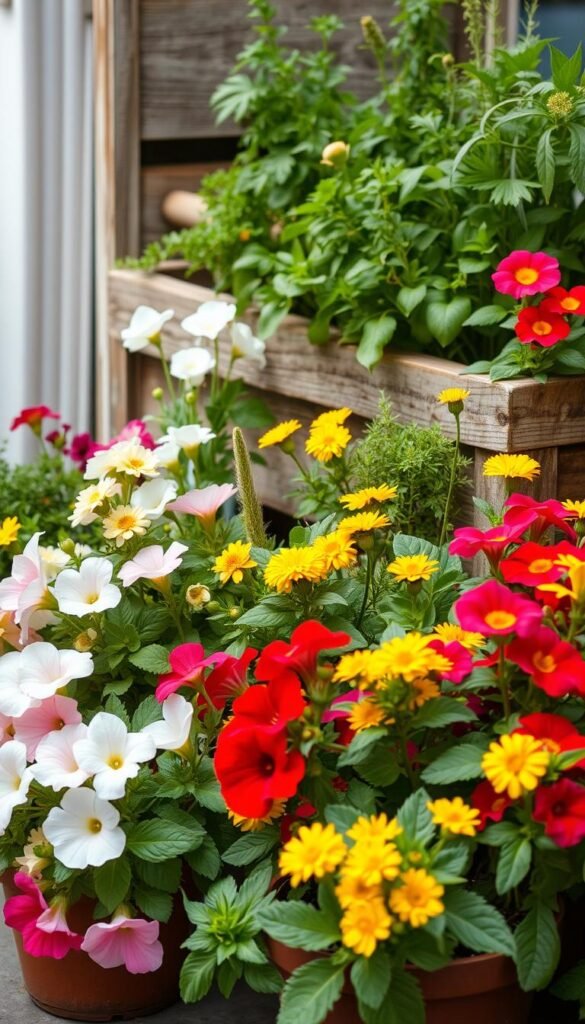
Space optimization shines brightest when using vertical arrangements. Stack pots on shelves or hang them from railings to multiply your planting real estate. Urban gardener Lila Torres notes:
“A well-placed trio of planters can transform a blank wall into a living mural overnight.”
Your secret weapon? Quality soil. Lightweight mixes with slow-release nutrients keep roots happy in confined quarters. This foundation prevents waterlogging while supporting vibrant growth – crucial when working with limited root space.
Love rearranging your setup? Portable displays let you chase sunlight patterns or create instant focal points. Swap out cool-weather pansies for summer geraniums as seasons shift. Even better: troubleshoot issues quickly by isolating plants that need extra care.
From apartment dwellers to busy families, this approach simplifies plant parenting. Start small with herbs or succulents, then expand as confidence grows. Your perfect oasis waits – no backyard required.
Key Considerations for Container Gardening Flowers
Unlock your potted garden’s potential by balancing three essentials: light, soil, and care. What works for ground-planted specimens often fails in confined spaces. Let’s explore how to set up your mobile oasis for success.
Assessing Sunlight and Shade Needs
Plants in containers dry faster than their in-ground cousins. Track how sunlight moves across your space through the day. Morning sun with afternoon shade suits most flowering varieties.
Pro tip: Use your phone’s compass app. South-facing areas get intense light, while north spots stay cooler. Match plants to these microclimates. As horticulturist Emma Carter advises:
“A sun-loving petunia in shade becomes a leggy disappointment.”
Choosing the Right Soil and Fertilizer
Bagged garden soil suffocates roots in pots. Opt for lightweight mixes containing perlite or vermiculite. These retain moisture while letting roots breathe.
Feed your blooms every 2-3 weeks with liquid fertilizer. Slow-release pellets mixed into soil provide steady nutrients. Remember:
- Clay pots need more frequent watering than plastic
- Self-watering systems prevent drought stress
- Mulch tops with pebbles to reduce evaporation
Rotate containers weekly for even growth. Watch for wilted leaves – they signal either thirsty roots or waterlogged soil. Your portable garden thrives when you adapt to its unique needs.
Seasonal Planning: Arranging Your Container Garden
Timing transforms ordinary pots into seasonal masterpieces. Early spring offers a golden window to establish plants that thrive in cool temperatures while preparing for summer’s heat. Let’s explore how to harness this transitional period for maximum visual impact.
Early Spring Planting Strategies
Start with cold-hardy varieties that shrug off lingering frost. Violas and pansies steal the show with their cheerful faces, blooming even when nights stay chilly. Position these in spots receiving at least 6 hours of daily sun – south-facing areas work best.
Maximize limited space using the thriller-filler-spiller technique. Place tall snapdragons center stage, surround them with compact primroses, and let trailing lobelia cascade over edges. This layering creates depth while accommodating root systems.
| Plant | Sun Needs | Spacing | Bloom Period |
|---|---|---|---|
| Pansies | Full to partial | 6-8 inches | Spring to early summer |
| Violas | Full sun | 4-6 inches | 6-8 weeks |
| Snapdragons | Full sun | 10-12 inches | Late spring to frost |
As days lengthen, gradually introduce heat-loving replacements behind existing blooms. Professional grower Nate Johnson suggests:
“Tuck young geraniums between pansies – when warmth arrives, simply remove the cool-season plants.”
Rotate pots weekly for even growth. Use liquid fertilizer every 14 days to sustain flowering power. By planning transitions now, your display evolves seamlessly through seasons.
Creative Container Arranging Ideas
Transform ordinary pots into living sculptures that elevate your surroundings. Strategic arrangements turn functional planters into artistic statements, whether dressing up a patio or enhancing windowsills.
Layering Colors and Textures for Impact
Start by grouping three pots in varying heights. Place tall ornamental grasses in the back, medium-height lavender in the middle, and trailing thyme up front. This creates depth while maximizing small areas.
Mix matte and glossy foliage for visual intrigue. Pair velvety sage leaves with shiny basil in one planter. Add pops of purple with flowering oregano between pink begonias. Landscape designer Mia Chen recommends:
“Treat herbs like textural accessories – their foliage often outshines blooms.”
Bring indoor charm outside by repeating your home‘s color scheme. Match terracotta pots to earthy decor, or choose cobalt blue vessels that echo accent walls. For quick refreshments, swap seasonal flowers while keeping rosemary or thyme as permanent anchors.
Try these eye-catching combos:
- Silver dusty miller + red geraniums + creeping lemon thyme
- Feathery dill + orange marigolds + cascading sweet potato vine
- Spiky lavender + soft petunias + curly parsley edges
Rotate arrangements monthly to keep your home‘s exterior dynamic. Even simple changes like moving a potted mint centerpiece can redefine a space instantly.
Colorful Container Gardening Flowers to Brighten Any Space
Elevate your outdoor areas with clever use of vertical displays and smart plant choices. Hanging baskets burst with life when you mix trailing lobelia with upright fuchsias. Wall-mounted planters save floor space while adding pops of colors to blank surfaces.
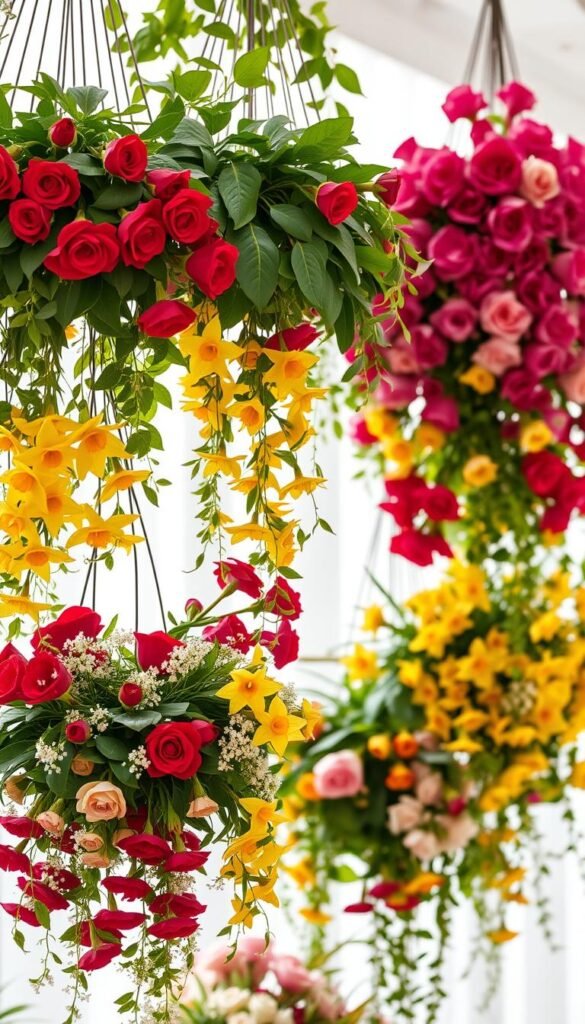
Weather plays a big role in your success. In hot climates, choose heat-tolerant lantana or portulaca. For rainy regions, opt for drainage-friendly pots and mildew-resistant impatiens. Master gardener Rosa Martinez advises:
“Rotate hanging displays weekly to ensure even sun exposure – it prevents lopsided growth during shifting seasons.”
Build harmony by pairing warm and cool tones. Try coral geraniums with purple verbena for contrast. Silver-leaved plants like dichondra make bold colors pop. For low-maintenance options, consider these resilient bloomers:
| Plant | Sun Tolerance | Weather Resilience |
|---|---|---|
| Zinnias | Full sun | Drought-resistant |
| Begonias | Shade-friendly | Handles humidity |
| Calibrachoa | Partial sun | Rain-tolerant |
Adjust care as weather changes. Move hanging baskets to sheltered spots during storms. In dry spells, water early morning to reduce evaporation. With strategic planning, your arrangements thrive through summer heat and autumn chills.
Tips for Watering and Fertilizing Container Plants
Did you know your potted plants might be thirstier than garden beds? Soil in confined spaces dries faster and loses nutrients quicker. Master these care techniques to keep your greenery thriving through every season.
Material matters when choosing pots. Terra cotta breathes better but needs watering 2-3 times weekly. Plastic holds moisture longer – perfect for forgetful waterers. Self-watering types help during vacations or heat waves.
Adjust routines as leaves change color in fall. Cooler temperatures mean slower evaporation. Cut back watering by 25% when nighttime temps dip below 50°F. Switch to low-nitrogen fertilizer to prepare plants for dormancy.
Timing fertilizer applications boosts effectiveness. Feed blooms early morning or late afternoon – midday sun burns roots. Use liquid formulas every 14 days during growth spurts. Garden coach Tyler Nguyen advises:
“Mark your calendar for feeding days. Consistency prevents feast-or-famine cycles that stress plants.”
Watch for yellow leaves or stunted growth – signs of hungry roots. A balanced 10-10-10 mix usually fixes deficiencies. Flush soil monthly to prevent salt buildup from nutrients. Your attentive care keeps displays lush from spring’s first buds to fall’s final flourish.
Utilizing Different Types of Containers
Your plant’s home matters more than you think. The right vessel affects growth, moisture levels, and even your display’s visual appeal. Let’s explore how material choices and creative upgrades impact your greenery.

Comparing Terra Cotta, Plastic, and Self-Watering Options
Terra cotta offers classic charm but dries soil quickly – ideal for drought-tolerant petunias. Plastic pots retain moisture better, perfect for thirsty flowers like fuchsias. Self-watering systems maintain consistent hydration, reducing maintenance for busy plant parents.
| Material | Drainage | Weight | Best For |
|---|---|---|---|
| Terra Cotta | Excellent | Heavy | Succulents, herbs |
| Plastic | Moderate | Light | Annual blooms |
| Self-Watering | Controlled | Medium | Vegetables, tropicals |
Creative DIY Container Ideas
Transform ordinary objects into eye-catching homes for your flowers. Drill drainage holes in vintage tea tins for compact petunias. Paint faded plastic pots with weatherproof acrylics to match your patio decor. Urban gardener Diego Reyes suggests:
“Old colanders make perfect hanging baskets – line them with coconut fiber before adding potting mix.”
Upcycle wooden crates into multi-level displays. Stack them vertically, filling each tier with trailing lobelia and upright petunias. Always ensure proper drainage by adding pebbles beneath your potting soil. Your creativity becomes part of the garden’s story.
Incorporating Edible Flowers and Herbs
Why choose between pretty and practical when your pots can deliver both? Edible blooms like nasturtiums and calendula add zest to salads while brightening up container gardens. Their peppery petals and citrusy notes turn ordinary dishes into gourmet experiences.
Many edible varieties thrive in partial shade, making them perfect for balconies with limited sunlight. Try these dual-purpose stars:
- Nasturtiums: Bold orange blooms love morning sun
- Calendula: Golden petals tolerate afternoon shade
- Borage: Star-shaped flowers attract pollinators
Herbs like thyme and mint work as living mulch beneath taller plants. Tuck basil between petunias – its glossy leaves complement purple blooms while keeping pests at bay. Chef-turned-gardener Elena Park suggests:
“Snip chive flowers over soups for oniony crunch. They’re nature’s confetti!”
Create edible arrangements using this simple formula:
| Light Condition | Edible Flower | Companion Herb |
|---|---|---|
| Full Sun | Marigolds | Rosemary |
| Partial Shade | Pansies | Lemon Balm |
| Dappled Light | Violas | Parsley |
Refresh your container gardening routine by harvesting blooms for tea infusions or freezing them in ice cubes. The more you pick, the more they’ll produce – turning your patio into a self-renewing pantry.
Designing for Small Spaces and Balconies
Your balcony holds untapped potential for lush greenery. Vertical gardening techniques let you grow upward instead of outward, turning blank walls into vibrant plant displays. This approach works wonders in tight quarters where floor space comes at a premium.
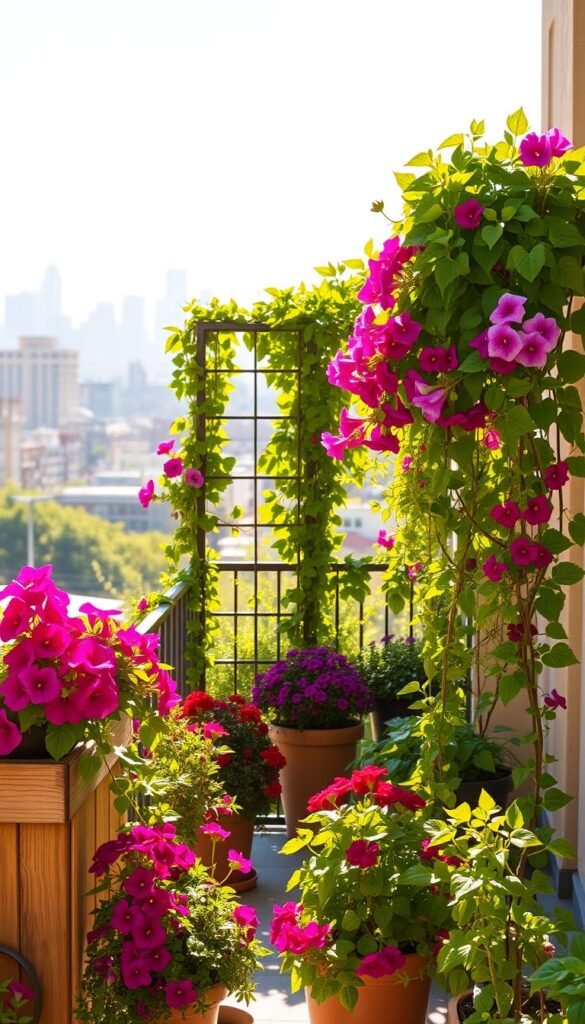
Vertical Gardening and Hanging Planters
Start by mounting wall pockets with herbs like oregano or thyme that thrive in full sun. Use lightweight potting soil mixed with water-retaining crystals – essential for elevated planters that dry quickly. Urban gardener Marco Silva suggests:
“Layer trailing ivy beneath compact strawberries in hanging baskets. You’ll get edible rewards and visual drama.”
For sunny spots, try these space-saving combos:
| Plant Type | Sun Needs | Container Style |
|---|---|---|
| Succulents | 6+ hours daily | Wall-mounted trays |
| Cherry Tomatoes | 8 hours minimum | Hanging upside-down planters |
| Petunias | Partial afternoon shade | Rail-mounted boxes |
In early spring, begin with cold-tolerant alyssum and snapdragons. These establish roots before summer heat arrives. Rotate hanging baskets weekly to ensure even growth – plants lean toward sunlight quickly in full sun conditions.
Choose potting soil labeled for containers, not garden beds. These blends drain faster while holding nutrients. For beginners, start small with a three-tier shelf system in early spring. Add more levels as your confidence grows through the season.
Incorporating Seasonal Décor into Your Garden
Refresh your outdoor spaces by weaving seasonal charm into your potted displays. As temperatures shift, simple swaps keep your arrangements looking fresh. Let’s explore how to blend natural growth with decorative touches for year-round appeal.
Spring and Fall Accent Ideas
Spring bursts with renewal energy. Nestle painted eggs or pastel ribbons among emerging garden blooms. As tulips fade, tuck heat-tolerant marigolds behind them for seamless transitions into early summer.
Autumn calls for warm textures. Swap summer annuals for mums and ornamental kale. Add mini pumpkins or cinnamon sticks to balcony planters. Landscape stylist Clara Benson recommends:
“Wrap burlap around pots for cozy fall vibes. It complements orange chrysanthemums perfectly.”
Try these seasonal pairings:
| Season | Plant Picks | Décor Elements |
|---|---|---|
| Spring | Pansies, ranunculus | Bird nests, pastel stones |
| Fall | Sedum, heuchera | Pinecones, copper tags |
In early summer, bridge seasons with dual-purpose plants. Coral bells offer colorful leaves that last through frost. Hang woven baskets with trailing ivy – they work in spring showers and fall breezes.
Rotate decorative accents monthly. Move ceramic frogs from garden beds to balcony railings. Switch cushion covers to match your blooms’ evolving palette. Small changes make big impacts.
Showcase Your Favorite Container Garden Arrangements
Local enthusiasts prove creativity thrives in small spaces. Their innovative designs turn everyday pots into neighborhood showstoppers, blending personality with practicality.
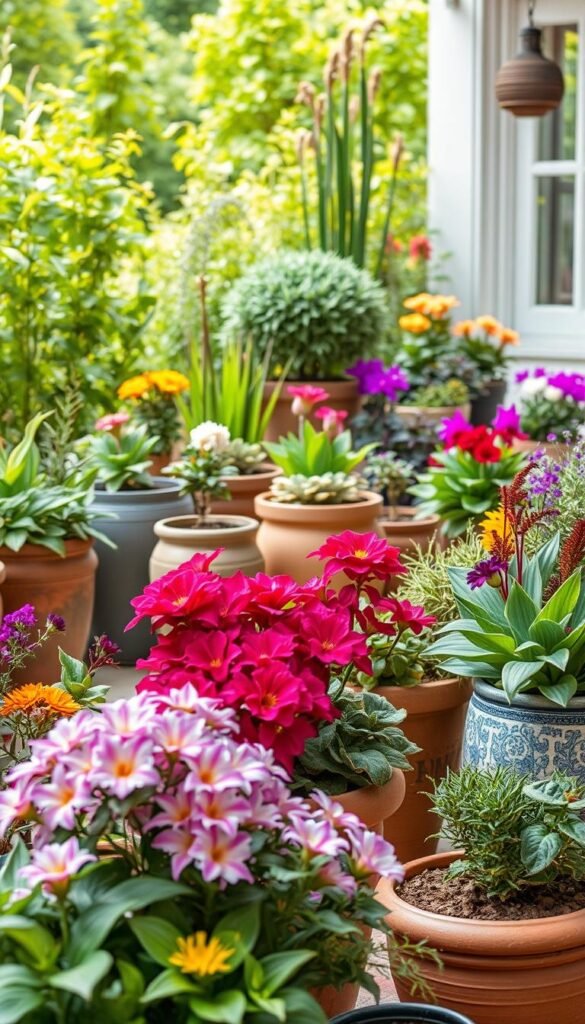
Inspiration from Local Gardeners
Portland gardener Aisha Patel transformed her 4-foot balcony using tiered planters. Her mix of coral geraniums and silver dichondra creates a cascading color waterfall. “Group odd-shaped pots for visual rhythm,” she suggests. “Let one bold hue anchor the design.”
Social media trends reveal clever hacks. @UrbanJungleDIY stacks painted crates for vertical herb displays. Their chartreuse sage and purple basil combo gets 10K+ likes monthly. Try these replicable ideas:
| Style | Color Palette | Planter Type |
|---|---|---|
| Modern Minimalist | White + Lime Green | Geometric Concrete |
| Rustic Charm | Terracotta + Navy | Distressed Wood |
| Coastal Vibes | Aqua + Coral | Woven Seagrass |
Chicago grower Marcus Lee uses thrifted teapots for succulents. His secret? “Add drainage holes with a ceramic drill bit.” Share your creations using #PotMagic – many local nurseries feature top posts.
Borrow techniques from these standout projects:
- Paint dollar-store pots with weatherproof spray
- Use trailing ivy to hide uneven edges
- Rotate displays weekly for Instagram-worthy angles
Troubleshooting Common Container Garden Issues
Even thriving potted gardens face challenges. Spotting problems early keeps your patio displays healthy. Let’s tackle common headaches before they ruin your green oasis.
Managing Pests and Overwatering
Tiny invaders love cozy planters. Check leaves weekly for holes or sticky residue. Blast aphids with water or apply neem oil – it’s safer than harsh chemicals.
Overwatering drowns roots in soggy soil. Wait until the top inch feels dry before giving drinks. Clay pots help prevent this issue by drying faster than plastic. For patio plants in heat, water deeply at dawn to combat evaporation.
Addressing Nutrient Deficiencies
Yellow leaves often scream hunger. Heat speeds nutrient loss through frequent watering. Feed plants monthly with balanced fertilizer during growth seasons.
Improper shades affect soil health. Dark containers in full sun bake roots, blocking nutrient uptake. Light-colored pots or strategic placement under shades prevents this. Try this quick fix guide:
| Symptom | Likely Cause | Solution |
|---|---|---|
| Purple stems | Phosphorus lack | Add bone meal |
| Brown edges | Salt buildup | Flush soil |
| Stunted growth | Nitrogen deficit | Use fish emulsion |
Master gardener Lena Choi advises:
“Prevent 80% of issues with morning checkups. Catch problems while they’re small.”
Rotatepatiopots to ensure even light exposure. Your vigilance keeps displays vibrant throughheatwaves and cool snaps alike.
Advanced Tips from Expert Gardeners
Ever wonder how pros keep their potted displays thriving year-round? Veteran growers like Barbara Wise reveal clever tricks that elevate ordinary arrangements. Their methods blend science with artistry, turning basic setups into living masterpieces.
Wise suggests using violas as multi-season stars. “Plant them behind spring bulbs – when tulips fade, violas fill the gap beautifully,” she explains. This technique extends your display’s visual impact through three seasons.
Try these advanced ideas for smarter growing:
- Bury tea bags near roots for slow-release nutrients
- Use chopsticks as mini trellises for trailing stems
- Paint pot rims with copper paint to deter slugs
Master timing by tracking your local frost dates. Start fall violas indoors 8 weeks before last heat wave. They’ll bloom until snow flies when transplanted in cooled autumn soil.
| Season | Viola Care Focus | Pro Tip |
|---|---|---|
| Spring | Root development | Use fish emulsion weekly |
| Summer | Heat management | Mulch with marble chips |
| Fall | Bloom extension | Add phosphorus monthly |
Precision watering makes all the difference. Insert a wooden skewer – if it comes out dry, water deeply. For hungry violas, mix banana peel tea into your routine. The potassium boost encourages continuous flowering.
Rotate ideas each season to keep displays fresh. Try vertical stacks of viola-filled gutters in spring, then transition to elevated troughs come fall. Your creativity becomes the ultimate gardening tool.
Budget-Friendly Container Garden Ideas
Who says you need deep pockets to create stunning porch displays? With clever repurposing and smart plant choices, you can design eye-catching arrangements for less than a fancy coffee order. Let’s explore wallet-friendly ways to turn everyday items into thriving green spaces.
Start by hunting for unconventional planters at thrift stores or your garage. Old colanders become hanging baskets when lined with coconut fiber. Paint chipped coffee cans for a retro vibe – just drill drainage holes first. Gardening pro Tessa Moreno advises:
“One person’s trash becomes your treasure. I’ve grown basil in rain boots for three seasons!”
Geraniums shine as budget heroes. Their long bloom time means more color per dollar. Pair red varieties with silver-dollar plant in one large planter for contrast. Try these thrifty combos:
| Container | Plant Pairing | Cost |
|---|---|---|
| Tin Can | Mini Geranium + Creeping Jenny | $3 |
| Basket | White Geranium + Purple Alyssum | $8 |
| Wood Crate | Pink Geranium + Oregano | $12 |
Maximize impact on your porch by clustering three mismatched pots. Place tall geraniums at the back, herbs in the middle, and trailing vines up front. Swap plants seasonally – move pansies to shadier spots when summer heat arrives.
Save more by splitting nursery six-packs with neighbors. One $5 tray can fill multiple planters if divided carefully. Propagate geranium cuttings in water to expand your collection for free. Your porch paradise grows richer with each smart swap!
Conclusion
Your journey to vibrant spaces starts with a single pot. Through strategic plant pairings and creative arrangements, even compact areas become living art. Annuals like petunias and marigolds deliver season-long impact, while cold-hardy pansies bridge spring and fall with cheerful blooms.
Remember these essentials: match plants to your light conditions, use quality soil, and water smartly. Experiment with thriller-filler-spiller combos in upcycled containers. Rotate displays monthly to keep your setup fresh and thriving.
Pansies prove particularly versatile, offering early color and surviving light frosts. Pair them with trailing lobelia for dynamic contrast. Annuals give you freedom to reinvent your space yearly – try bold zinnias one summer and delicate alyssum the next.
Share your creations using #PatioPotMagic to inspire others. Whether you’re dressing up a balcony or framing a doorway, your living masterpiece awaits. Grab a planter, pick your first plant, and watch ordinary spaces transform through nature’s magic.

